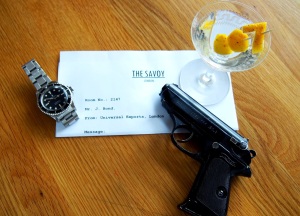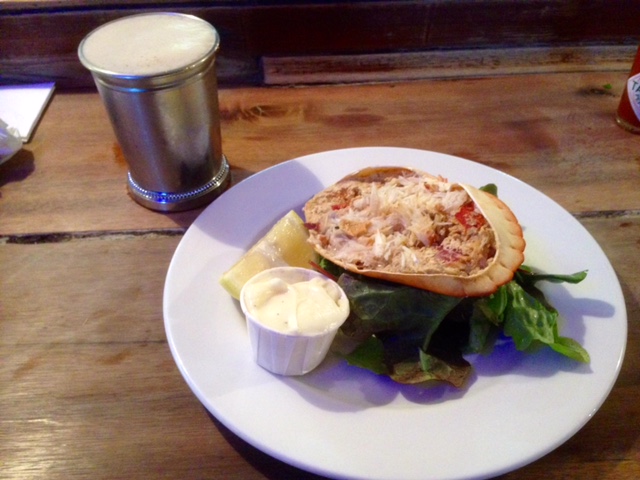“If one eats badly in England-or in any other country, for that matter-it is generally one’s own fault” – Ian Fleming.
In 1956, one could be forgiven for not being able to find the finest in English cuisine. Fleming was in a rather more privileged position to sample the best of English cooking from his homes in central London.
Retroculturati summarised in an excellent piece about Fleming’s article for Holiday magazine published in 1956:
He defends English food but not its cooks, and one finds it difficult to argue his point fifty or more years later:
“The problem in England is how to eat good English food without bad English cooking” Very true!
He believes English food to be the best in the world, unsurpassed in his view are:
“Colchester and Whitstable oysters, all English fish, particularly Dover soles; Scottish smoked salmon; potted shrimps; lamb cutlets; roast beef; York ham, nearly all the English vegetables, particularly asparagus and peas, English savouries and most English fruits”
Excerpt from Holiday magazine, April 1956
Nowadays of course English cooking is back in vogue, but Fleming always knew it could be great. His own cooking skills appeared to be reduced to only making scrambled eggs and he was certainly no snob about food as he freely admitted; he also loved the native Jamaican cuisine of curried goat, salt fish and ackee when relaxing at Goldeneye.
One area he had a degree in was drink. With tongue in cheek, Fleming describes how to get a good drink. He bemoaned the fact that it was ‘extremely difficult to get a good Martini anywhere in England’ but gave clear instructions on how to get what you want:
The way I get one to suit me in any pub is to walk calmly and confidently up to the bar and, speaking very distinctly, ask the man or girl behind it to put plenty of ice in the shaker (they nearly all have a shaker), pour in six gins and one dry vermouth (enunciate “dry” carefully) and shake until I tell them to stop.
You then point to a suitably large glass and ask them to pour the mixture in. Your behaviour will create a certain amount of astonishment, not unmixed with fear, but you will have achieved a very large and fairly good Martini.
So how did Fleming acquire all this knowledge of fine dining that many of his characters enjoyed in his books such as Bond’s dinner at the Splendide with Vesper consisting of caviar, small underdone tournedos with Bernaise sauce, artichoke hearts, an avocado pear with French dressing for dessert and Taittinger Brut Blanc de Blanc ’43?
We take a look at the array of fine London restaurants that were on his doorstep and whether they are still here today:
The Savoy Grill
The Savoy has a long association with James Bond and his creator, Ian Fleming. He was one of many authors who regularly visited The Savoy and the American Bar was one of Fleming’s favourite haunts.
He mentioned the hotel in several of his books including Dr No, Quantum of Solace and Diamonds Are Forever, where gem-smuggler Rufus B. Saye/Jack Spang called it home.
“She had sat next to Bond and chattered vivaciously about ‘what shows he had recently seen in town’ and ‘didn’t he think the Savoy Grill was the nicest place for supper. One saw so many interesting people – actresses and people like that”. – Quantum of Solace
Among the glitterati who frequently dined at the Savoy Grill was Sir Winston Churchill, Oscar Wilde, Charlie Chaplin, Frank Sinatra, Elizabeth Taylor, Rex Harrison, Doris Day, Ivor Novello and Marilyn Monroe. The world’s first Martini is said to have been mixed in here in 1910.
During the pre-production of Dr. No, Fleming invited Sean Connery to lunch, accompanied by Janet, Marchioness of Milford Haven (and cousin to Ivar Bryce) who gave her approval.
El Vino
El Vino wine bar located in the heart of Fleet Street was a regular watering hole for Fleming when he worked as a stockbroker, first for Cull & Co. and then for Rowe and Pitman. It is also a short trot from his writing office in Mitre Court and his famous Playboy interview was partly conducted there.

Photo: El Vino
Duke’s Hotel Bar
Fleming reputedly drank at Duke’s Bar and it is still going strong. Head barman Alessandro Palazzi pays tribute to Ian Fleming with dozens of cocktails inspired by the books including The Strangways, Fleming 89, Tiger Tanaka and of course, the Vesper Martini. For the Fleming 89, they use Polish vodka in honour of Polish-born Christine Granville, a wartime spy on who is one of the inspirations for the character of double-agent Vesper Lynd in Casino Royale..

Photo: https://drinkup.london
Scott’s

The original Scott’s
Fleming was a regular at this restaurant – originally located at 18-20 Coventry Street – during his time at the Admiralty. In a famous incident that Fleming described, the head waiter at the time ‘Baker’ called Scotland Yard on the suspicion that Fleming was a German spy, but he was surreptitiously ‘trying to get the captured captain and navigator from a U-boat drunk at Scott’s so as to worm out of them how they avoided our mine fields in the Skagerrak.’
Fleming also dined there many times with his great friend Robert Harling. In 1968 Scott’s relocated to 20 Mount Street, where coincidentally newly-cast Roger Moore discussed his role with Guy Hamilton in August 1972.
In You Only Live Twice, Bond plans to take Mary Goodnight to Scott’s to celebrate his promotion and new assignment; in Moonraker, it is mentioned that Bond’s favourite table was at the window above the street light and in Diamonds are Forever Bond takes Bill Tanner there for lunch:
“Come on, Bill,” he said. “If that’s all there is to it, I’ll buy you lunch. It’s my turn and I feel like celebrating. No more paperwork this summer. I’ll take you to Scotts’ and we’ll have some of their dressed crab and a pint of black velvet. You’ve taken a load off my mind. I thought there might be some ghastly snag about this job.”
“All right, blast you.”
Photo: http://www.literary007.com
The Ivy
The Ivy needs little introduction as it is still a favourite among the glitterati, as is The Ritz Restaurant, which was one of Ann Fleming’s favourites. Fleming loved the ambience and stained glass windows but it holds much more significance.
On May 12, 1952, Fleming asked his friend the author, poet and trusted reader how “you get cigarette smoke out of a woman once you have got it into her”. This was a tip-off to Plomer that Fleming had written his first novel – Casino Royale. Despite Fleming dismissing the manuscript as “oaffish”, Plomer, a reader for publishers Jonathan Cape insisted he show him. The rest they say is history.

Photo: Paul Winch Furness
Other Fleming Favourites
Quo Vadis and L’Etoile were frequented by Fleming and are still going strong today. Overton’s had two locations, one in St. James and one located opposite Victoria station is no more.
One of the oldest restaurants still going is Wilton’s, which has the sort of classical elegance of a similar London dining institution Rules, that is the oldest restaurant in London. It was located in Bury Street until it moved to Jermyn Street. According to Gary Giblin from his masterly ‘James Bond’s London’, the head Oysterman Patrick Flaherty used to hand deliver parcels of smoked salmon, lobster and oysters to Fleming’s Victoria Square home.
Wheeler’s was originally created in 1856 by Captain Wheeler in Whitstable, Kent and later brought to London’s Old Compton Street by Bernard Walsh who was regularly visited by, Francis Bacon, Lucian Freud, Richard Chopping and Denis Wirth-Miller. It is now under the ownership of Marco Pierre White with locations at St. James’s Street and Threadneedle Street but still maintains the traditions of English food where you can get a good Dover Sole.
Even in the 1950s, Fleming remarked that you could not guarantee in any of these places, the hope to see interesting people “in the sense that the old Café Royal in Regent Street used to be the haunt of artists and writers” but he thought the “Savoy Grill is probably your best bet.”
Have you tried any of these restaurants still here today? Tell us what you think!
Incidental Intelligence
Ian Fleming Walking Tours – City of London
Dying to Eat: The Food of Literary James Bond







Lovely photos, great article!
Brizzola (or brasato) has a similar name as the Italian beef cut, braesola. Roast beef braised in red Barolo wine is placed beneath a high heat broiler to provide a fork tender meat with a crunchy top. This savory dish is described accurately in Diamonds Are Forever:
Felix tells Bond, “They’ve got some of the finest meat in America here, and Brizzola’s the best cut of that. Beef, straight-cut across the bone. Roast and then broiled. Suit you?”